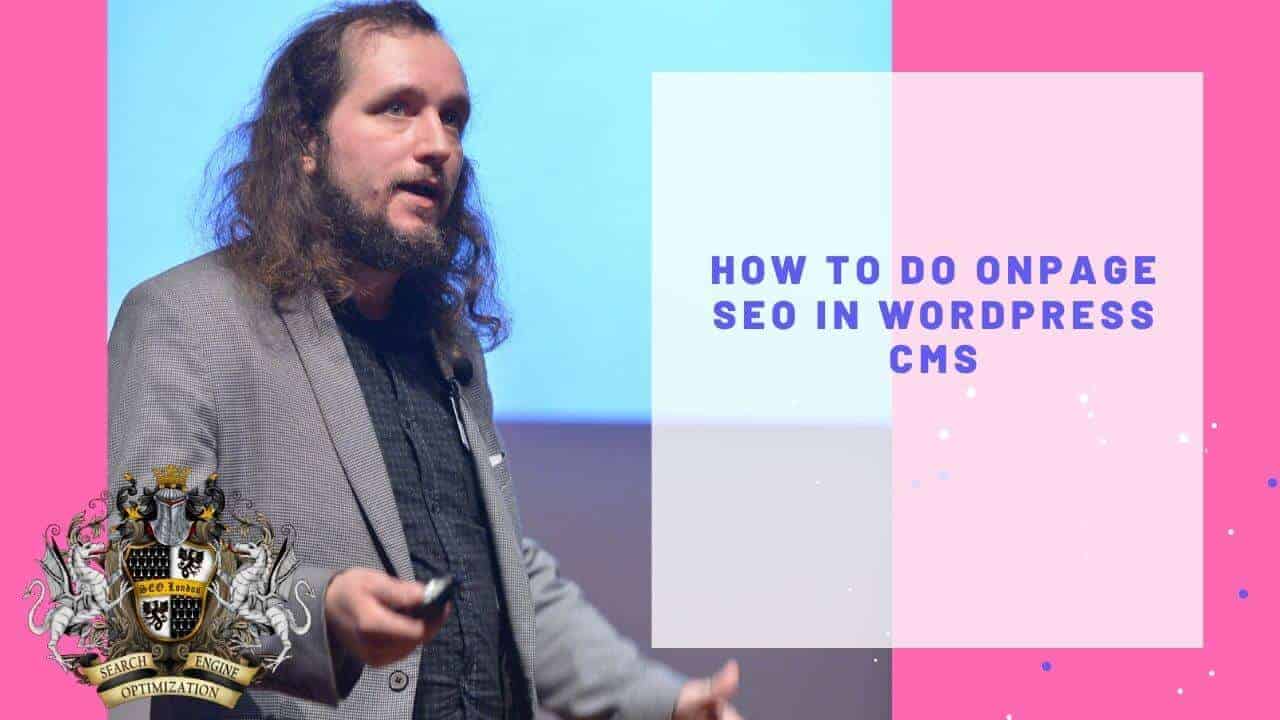Introduction to On-Page SEO Strategies To Implement for WordPress CMS
You are probably aware of the important role that on-page SEO plays in your online success. Backlinks may still be weighted more heavily in Google’s algorithm when ranking sites, but on-page SEO has to be superb if you want to rank for your desired terms and keywords. If you execute the techniques below you can beat your competition. If you fail to implement them, however, you will miss out on attention, sales, and conversions in your marketplace.
Put the Keyword in the Front of the Title Tag
If you search a popular keyword, such as “make money online,” you’ll find that most of the top search results include the keyword near the front of their title tag. For instance, you would see: “Make Money Online in Three Simple Steps” instead of “Three Easy Steps to Make Money Online.” This front loading in the first headline example communicates to Google that the content must be more relevant to audiences searching that term than the other one. So go through all of your blog posts and change their titles to mention the main keyword in the first portion today. It’s one the lowest hanging SEO fruits you can start benefiting from almost instantly.
Search Engine Friendly URLs in Your CMS
Don’t make the common mistake of creating a URL that is long and complicated. This is unfriendly to people and search engines alike. For instance, avoid “http://www.example.com/cars/salesinquiry/24522/vpa3/23/call-us-for-free-eval.jsp” and instead simplify it. Take out the excess information and include your keyword. Google uses your URL to ascertain what the topic of your page is. In order to rank highly for your target terms, you need to get rid of dates, categories, and other information that clouds up the search bar. So for the example above, you might opt for “http://www.example.com/car-sales” instead.
Go Multimedia
In today’s internet age, users expect more than just a block of text. If you add extra media, such as videos, photo, and audio content, you can increase your user engagement. While the multimedia doesn’t directly boost your search engine ranking from keywords (Google’s algorithm can’t listen to audio, watch videos, or view images), Google does account for the amount of time spent on your site and the number of clicks users take when determining your ranking. Thus, multimedia can make users interact more with your site and help your rank order.
Link Out to Other Web Pages
Outbound links (from your website to another website) are helpful for your on-page SEO. They indicate to Google that you are participating in the greater world of the internet, not just your own domain. Include a few links to authority websites, which include popular industry sites, .edu domains, .org domains, and .gov domains. However, avoid making these “nofollow” links, it might look like you’re trying to hoard the PageRank all for yourself.
Front Load Keywords
In your post or article, you want to put your keyword at the front, within the first 100 words or so. Google’s algorithm detects this and assumes it makes your content more relevant for that term. However, keep in mind that “spamming” your keyword (trying to achieve a high level of keyword density in your content) no longer works. In fact, it may cause Google to penalize you for attempting to abuse their system. Aim for 1-3% keyword density for your content. If your target search term is “red shoes” then you would include it 1 to 3 times in a 100-word article.
Hug Your Keyword With H1 Tags
Many people wonder where to put their H1 tags for maximum SEO results. The simple secrets are to make sure your keyword is surrounded by H1 tags and to put the headline at the top of your post. Some platforms like WordPress, automatically do this for you. But beware, if you have a custom theme on your site it could change these settings. Always do a double-check before taking a new post live.
Fast Load Speed and WordPress
Your page needs to be fast. Google has publicly confirmed that page load speed has a big effect on SEO. They even created a tool for you to manage your speed called PageSpeed Insights. Use this tool to diagnose your weaknesses and implement solutions to quicken up your site.
Title Tag Modifiers
Place modifiers in your title tag that capture long tail keywords. This means you are targeting a niche within a larger category in the efforts to rank for it. For example, it will be very competitive to rank for “weight loss.” But if you take the title tag modifying approach, you could say “Weight Loss Tips: The Best Exercises for New Mothers.” Here, “New Mothers” is the specific modifier that could call out directly to your target audience (and encourage Google to put you at the top of the results).
Put Modifiers In Your Title Tag
A great technique to capture searches for long tail key terms is to use modifiers in your title. For example, instead of saying “Best Fashion Tips for Fall” you can put “Best Fashion Tips for Fall 2020.” This makes it more specific and more likely to rank for long tail searches.
Social Media
This is a simple fix to increase your rankings. Put prominent social sharing buttons at the top, side, and bottom of your site. Even better, hire a developer or download a plugin to make your sharing buttons “float” with the user, so they are always visible on your page. This increases the likelihood of your audience posting your content to a social site. And social links to your page boost your rankings.
Make it Lengthier
Google loves length. They prefer to rank a 1,000-word article over a 100-word article, all things being equal. On average, the top 10 results are between 1,800 and 2,000 words, so aim for that sweet spot if you want to squeeze that extra bit of SEO juice out of your posts.
Lower the Bounce Rate
A high bounce rate will stop your search engine efforts. A “bounce” is when someone visits your site but immediately leaves. This tells Google your site isn’t valuable to them. If you keep getting this result, you’ll fall off the front page. One way to decrease bouncing is to have relevant internal links to your other related content on your landing page. This raises the chances of a visitor staying on your domain, saving you a bounce.
LSI Keywords and OnPage SEO in WordPress
Latent Semantic Indexing (LSI) means words that are strongly related to your keyword. For example, LSI for “muscle gain” would be “build mass,” “get buff,” and so on. Google likes to see these LSI near your main keyword. They have collected near infinite amounts of data about what people are searching for, so your inclusion of these related terms means you have quality content to offer the market.
Engagement
You want visitors to stay on your site for as long as possible. Similar to bounce rates, engagement metrics are essential for great SEO. If google sees people spending hours on your site rather than seconds, your rankings could see a boost.
Internal Links
Just as putting external links in your posts is important, putting internal links on display is too. Try to create anchor links that contain keywords relevant to your audience. It proves to Google that you have a consistent theme among your web presence.
Don’t Forget H2 and H3 Tags
Put your main terms in an H2 or H3 tag at least once. Sure, it doesn’t have as much power as your H1, but it still makes a difference to on-page SEO. Plus, it makes it easier for your viewers to browse around.
Image Optimization for OnPage
There are certain ways to add clues to your images for Google to use. There is the ALT tag and the description. Both of these sections of your image upload allow you to put information related to the terms you’re wanting to be ranked for. Just don’t overdo it: the algorithm can catch spammy images.
Click Paths and OnPage SEO
Typically, your homepage has the highest PageRank in your entire site’s domain. Thus, you want your other URLs to be as close to this page in the “click path” as possible. This means that it takes 2 or 3 clicks rather than 10 clicks to reach a certain page from the homepage. So change “Home>Products>Shirts>Color>Size>Brand>ProductName” to “Home>Products>ProductName” for better results.
CTR and OnPage SEO for WordPress
Your CTR (Click Through Rate) is crucial for great SEO. Essentially, the CTR is determined by the number of times a user clicks on your page divided by how many times your page shows in the results. A higher click through rate means your content is more relevant to users searching for that term. Be sure to test different headlines and meta descriptions to see which one converts better for your market.
There they are. Eighteen powerful and proven techniques to boost your on-page SEO. These strategies can all benefit your online marketing, so run the checklist on all of your content. Start with the quick, simple fixes and then be sure to move into more complex tactics as you gain momentum. Once you do, you’ll enjoy more sales and conversions than ever before
 Published in: March 2021
Published in: March 2021
Last Updated in 2022-12-28T11:48:21+00:00 by Lukasz Zelezny



